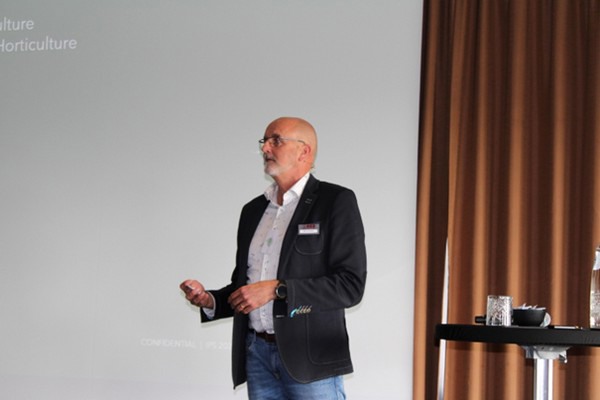On Wednesday, Grodan held its International Propagation Seminar. Plant breeders from all over the world were gathered in Dordrecht. After a very enjoyable lunch, Andrew Lee officially opened the seminar. Paul Jochems was the first speaker. Paul Jochems works at Red Horticulture.

Role of spectrum on length growth for grafts
Paul spoke about the specific possibilities of using spectrum in controlling the length of tomato plants before grafting. RED Horticulture has conducted research at their agronomic and photobiological research centre PARC on the effect of red and blue light on the length of young tomato rootstock and variety. Red provides extra elongation. Unlike blue light. With blue light, length decreases. Spectrum can also help influence that length a few days before grafting to stay within the grafting schedule.
 Paul Jochems, Red Horticulture. View the entire photo report here.
Paul Jochems, Red Horticulture. View the entire photo report here.
Grafting master class
Johan Bruins was the next speaker. He gave a masterclass in grafting. Grafting is an important phase in the cultivation of tomatoes and cucumbers. Cucumber and tomato plants are mainly grafted to provide resistance to diseases or to give more vigour and production. There are many ways to graft and cure plants. But how important is the quality of the rootstock and graft for grafting? The ins and outs will be shared with you later on this channel. To be continued.
 Joost Haenen, Grodan. View the entire photo report here.
Joost Haenen, Grodan. View the entire photo report here.
Thieves
The presentation by Joost Haenen, and Grodan, was about the effect of threshing young plants. Plants are now threshed to get homogeneous planting material and higher production with lower energy input. Threshing releases extra hormones in the plant. The plant grows longer. And the plant gets stronger. Joost mentioned some points of attention for thieving: "Choose the right time of day, keep the light on and keep the block wet. Of course, also be careful not to damage the rest of the plant."
Research shows that thieving at the second leaf produces the best results. The best results here stand for the highest production. The charts shown showed production per m². The measurements ran up to week 36. Joost: "Besides the production per m², by the way, we also saw that plant quality remained the same throughout the production phase with the various thieving methods."
Joost got a lot of discussion going. The interaction in the audience was good. Seminar participants answered each other's questions. Joost: "And that is exactly what we want to achieve with this event. The International Propagation Seminar is set up as a knowledge event. We learn from each other."
Stone wool
Kurt van Durme, responsible for product development at Grodan, explained that stone wool is quite easy to make. But also that there are a lot of possibilities with it. Stone wool is simply molten basalt plus binder (= glue). That is the starting point. And within that starting point, there is a lot of freedom to give it certain characteristics. Points such as the density and diameter of the fused basalt fibres affect water absorption and water retention. And the binders can also be controlled. Kurt explained that Grodan is getting ever closer to the process of applying a sustainable binder. One that is bio-based and degradable.
Information on ToBRFV-resistant varieties
Finally, we heard James du Preez speak. James works as an account manager at Rijk Zwaan. He touched on a few topics such as: "The addition of ToBRFV resistance has nothing to do with seed and plant quality. It is separate from it. Furthermore, like Joost, he challenged the audience to join the conversation. James was particularly curious to know what information about new varieties the plant breeder hopes to receive from breeders. And again, as with Joost's presentation, there were many responses from the audience.
After work is done, it is good to rest. And certainly while enjoying a good gin. After the presentations, the club left for the 14th floor to start the gin tasting. So ... Living the good life.
Check out the photo report here.
For more information:
Grodan
[email protected]
www.grodan.com
